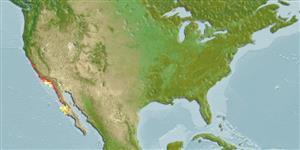>
Ovalentaria/misc (Various families in series Ovalentaria) >
Embiotocidae (Surfperches)
Etymology: Micrometrus: Greek, mikros = small + Greek, metros = metre (Ref. 45335).
Eponymy: Aurora was the Roman goddess of the dawn. In the case of the goby, the name refers to the pattern on its caudal fin being ‘…reminiscent of the rising sun’. The name is often applied to species with pink/yellow colouration. (Ref. 128868), visit book page.
More on authors: Jordan & Gilbert.
Environment: milieu / climate zone / depth range / distribution range
Ökologie
seewasser demersal; tiefenbereich 0 - 6 m (Ref. 96339). Subtropical; 38°N - 27°N, 123°W - 114°W
Eastern Pacific: Tomales Bay in northern California, USA to northern central Baja California, Mexico.
Size / Gewicht / Alter
Maturity: Lm ? range ? - ? cm
Max length : 18.0 cm TL Männchen/unbestimmt; (Ref. 2850)
Adults usually occur in shallow rocky areas; in tide pools and at depths up to 6.1 m. Feed on algae and small invertebrates (Ref. 2850). Viviparous, female carries the developing young (Ref. 205).
Life cycle and mating behavior
Geschlechtsreife | Fortpflanzung | Ablaichen | Eier | Fecundity | Larven
Viviparous, female carries the developing young (Ref. 205).
Eschmeyer, W.N., E.S. Herald and H. Hammann, 1983. A field guide to Pacific coast fishes of North America. Boston (MA, USA): Houghton Mifflin Company. xii+336 p. (Ref. 2850)
IUCN Rote Liste Status (Ref. 130435: Version 2024-1)
Bedrohung für Menschen
Harmless
Nutzung durch Menschen
Tools
Zusatzinformationen
Download XML
Internet Quellen
Estimates based on models
Preferred temperature (Ref.
123201): 12.9 - 17.8, mean 15.9 °C (based on 35 cells).
Phylogenetic diversity index (Ref.
82804): PD
50 = 0.7500 [Uniqueness, from 0.5 = low to 2.0 = high].
Bayesian length-weight: a=0.01318 (0.00547 - 0.03178), b=3.05 (2.84 - 3.26), in cm total length, based on LWR estimates for this (Sub)family-body shape (Ref.
93245).
Trophic level (Ref.
69278): 2.7 ±0.3 se; based on diet studies.
Generation time: 3.0 ( na - na) years. Estimated as median ln(3)/K based on 1
growth studies.
Widerstandsfähigkeit (Ref.
120179): mittel, Verdopplung der Population dauert 1,4 - 4,4 Jahre. (K=0.3).
Fishing Vulnerability (Ref.
59153): Low to moderate vulnerability (30 of 100).
Nutrients (Ref.
124155): Calcium = 164 [86, 345] mg/100g; Iron = 1.32 [0.81, 2.35] mg/100g; Protein = 18.7 [17.7, 19.7] %; Omega3 = 0.284 [0.163, 0.494] g/100g; Selenium = 12.4 [6.5, 26.4] μg/100g; VitaminA = 19.8 [6.4, 61.0] μg/100g; Zinc = 1.27 [0.88, 1.84] mg/100g (wet weight);
